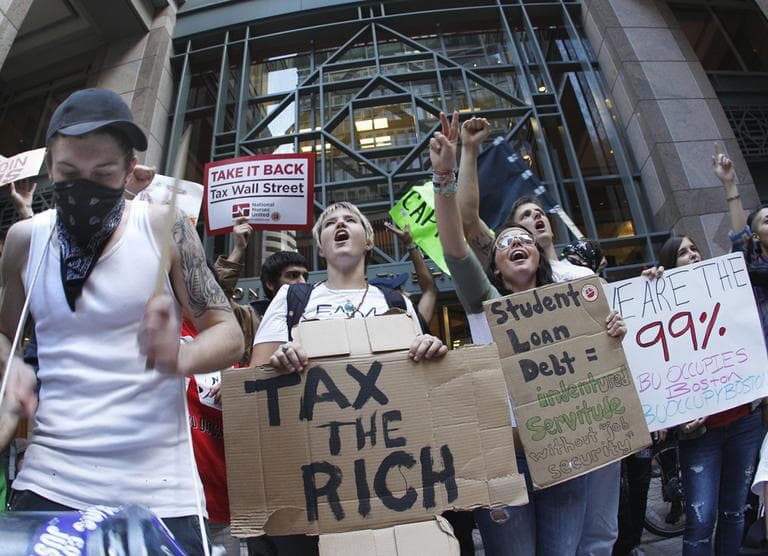Advertisement
Occupy Boston: Is This What Democracy Sounds Like?

President Obama and Gov. Deval Patrick have given their blessing to the "Occupy" movement growing around the country, including here in Boston.
It's been a week since economic protesters took over Dewey Square in front of Boston's Federal Reserve building. From the outside, these protesters look like traditional activists, holding signs, chanting complaints. But hearing them is something else. The leaderless organization communicates in the same way they want society to operate.
One thing about the protesters is that they hold a lot of meetings.
"The people's mic" is a way to amplify a speaker's voice. But it also becomes a ritual to make everyone feel united. Some say it makes them feel empowered.
"Welcome! Really quick, here's how we do G.A.," shouts Marisa Egerstrom. The Harvard Ph.D. student is shouting into a bullhorn.
G.A. stands for General Assembly, where everyone comes to together to talk about logistics or big actions. Today, Egerstrom is facilitating.
"Point of process," shouts a skinny man with a long beard. "I personally am uncomfortable with the use of a bullhorn. I believe that the people's mic is an incredibly effective mode of communication."
But he speaks haltingly, and after each phrase, the crowd of 20 or so people, repeats what he says. So it sounds like this:
Speaker: "I personally am uncomfortable."
Crowd: "I personally am uncomfortable."
Speaker: "With the use of a bullhorn."
Crowd: "With the use of a bullhorn."
Speaker: "I believe that the people's mic."
Advertisement
Crowd: "I believe that the people's mic.'"
Speaker: "Is an incredibly effective mode of communication."
Crowd: "Is an incredibly effective mode of communication."
"The people's mic" is a way to amplify a speaker's voice. But it also becomes a ritual to make everyone feel united. Some say it makes them feel empowered.
"Could we have a temperature check on that?," asks the man with the long beard.
"Temperature check" is how the group gauges opinion on an idea or proposal.
If they like it, they wiggle their fingers in the air. If they don't, their fingers wiggle downward. Fingers go in front if they're just so-so.
Three-quarters of the group has to agree on something before a proposal passes, and it can take strenuous debate to get there. That's especially true when it comes to actions such as demonstrating in front of the State House.
"We are the 99 percent! And so are you! We are the 99 percent, and so are you!," chanted the crowd Monday as they approached the State House. After the march, the group checked in on the success of the march. And even then, they used this strangely formal method for communicating.
Nadeem Mazen: "I also think."
Crowd: "I also think."
Mazen: "As part of my personal opinion."
Crowd: "As part of my personal opinion."
Mazen: "That the police didn't just not brutalize us."
Crowd: "That the police didn't just not brutalize us."
Mazen: "They also spent a fortune."
Crowd:"They also spent a fortune."
Mazen: "In terms of time and money."
Crowd: "In terms of time and money."
Mazen: "Our money."
Crowd: "Our money."
Mazen: "Guiding traffic."
Crowd: "Guiding traffic."
Mazen: "That was OK with me."
Crowd: "That was OK with me."
Most people disagree.
Peter: "I believe that the job of the police."
Crowd: "I believe that the job of the police."
Peter: "Is to protect the ruling class."
Crowd: "Is to protect the ruling class."
Peter: "A.K.A. the one percent."
Crowd: "A.K.A. the one percent."
Peter: "From people like us."
Crowd: "From people like us."
By the end, everyone agrees the police as individuals can be good people.
Proponents of this way of communicating say it gives everyone a voice and keeps the movement cohesive.
Jeff Stein, 22, says it's important to show people "another way of making decisions."
"Demonstrating that shows that we can build another world just in this very small sense," Stein says.
The consensus process and many of the rituals trace their roots to anti-Vietnam war activists. Specifically Quaker activists, who were dissatisfied with the mainstream Quaker church's response to that war. The group then became the Movement for a New Society, which played a big role in protests against the war nuclear industry.
Stein recognizes this isn't the most efficient way to do things. But he thinks the benefits of inclusiveness far outweigh any need for efficiency.
But it's this model that eventually undid the Movement for a New Society. That group eventually disbanded, because getting 3/4 consensus was just too limiting. Members also eventually disagreed about the importance of having a leader.
This program aired on October 7, 2011.